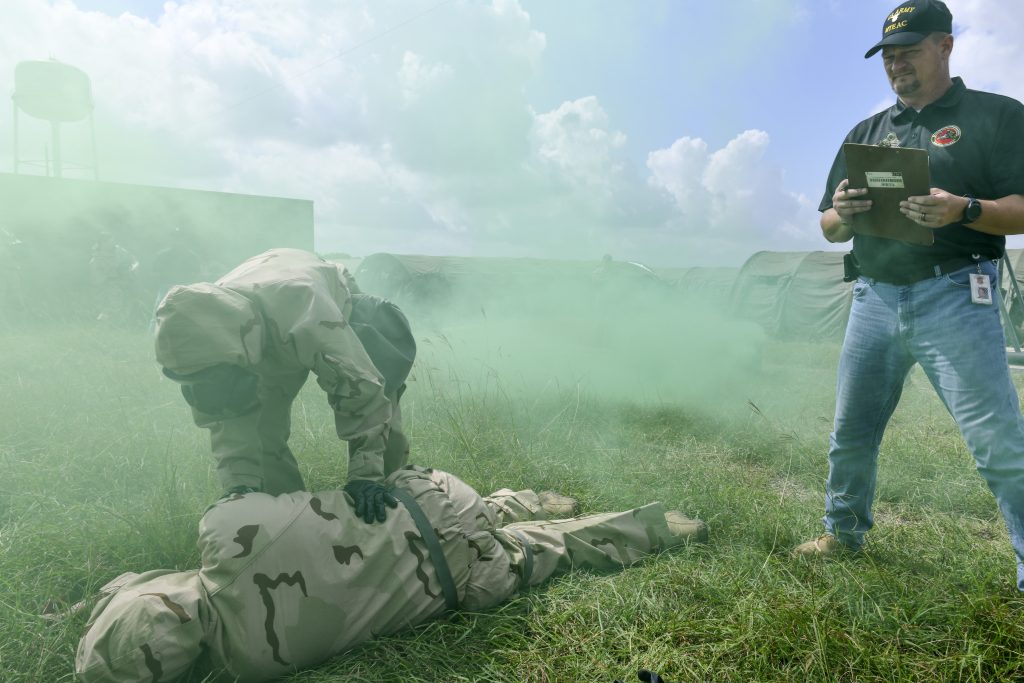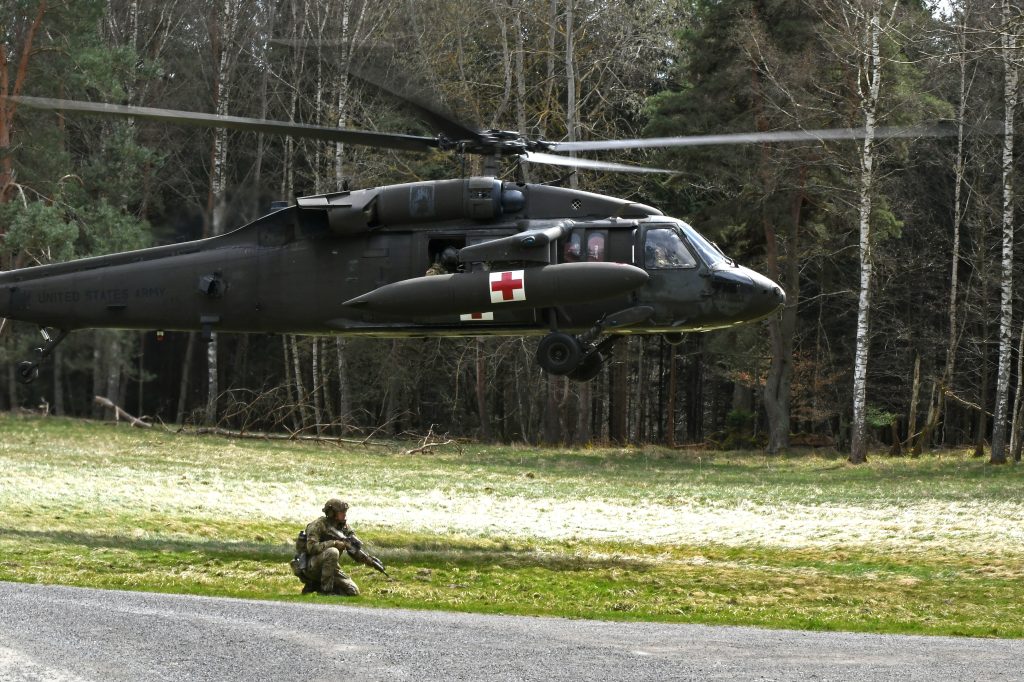
MOPP UP DUTY: Test players wearing Level 4 Mission Oriented Protective Posture gear advance to treat simulated casualties at a test in June 2021 at Camp Bullis, Texas. (Photo by Jose Rodriguez, U.S. Army Medical Center of Excellence)
JPEO-CBRND fills gap in Europe with rapid delivery of a lifesaving antidote.
by Meg Holahan, Alex Hillman, Kelly Burkhalter
The Russian invasion of Ukraine on Feb. 24, 2022, shocked the world, touching off the largest armed conflict in Europe since World War II. Between the unknown of an escalating war and the inability to predict Russia’s next move, the invasion put nations across the continent and the world on high alert.
DOD began moving quickly to ensure that U.S. forces located in the U.S. European Command area of responsibility remain prepared for any potential battlefield scenario. The joint force needs to be prepared to fight through any situation around the world, from large-scale combat operations to invisible threats that can incapacitate in seconds.
Since the conflict in Ukraine began, there has been persistent concern about the potential use of chemical weapons, including opioids such as fentanyl and carfentanil. Opioids are highly potent and extremely dangerous. Exposure poses a significant risk to the joint force, as even extremely small doses of these substances—amounts equivalent to a few grains of salt—can cause breathing difficulties and even death in less than 10 minutes.

NOTEWORTHY TEST: Sgt. 1st Class Elijah Williamson, a U.S. Army Medical Test and Evaluation Activity test officer, takes notes as a test player practices administering the ROCS autoinjector on a simulated casualty during a test in June 2021 at Camp Bullis, Texas. (Photo by Jose Rodriguez, U.S. Army of Excellence)
OPIOIDS AS A BATTLEFIED THREAT
Russia has a well-documented history of using unconventional means to defeat any adversary, including the suspected use of chemical, biological and radiological agents. In 2002, one or more chemical agents (believed to be fentanyl derivatives) were used to end a hostage crisis at a large, crowded theater in Moscow. The incident resulted in several hundred civilian casualties. In 2018, Russian operatives used a Novichok nerve agent to poison former Russian military officer turned British spy Sergei Skripal and his daughter, Yulia, in Salisbury, England, and used Novichok again in 2020 to poison Russian opposition leader Alexei Navalny.
The U.S. Chemical and Biological Defense Program, recognizing the potential threat opioids could be for warfighters and the need for a rapid solution, directed its advanced development component, the Joint Program Executive Office for Chemical, Biological, Radiological and Nuclear Defense, to develop a medical countermeasure against this evolving threat. The JPEO-CBRND’s Joint Project Manager for CBRN Medical Chemical Defense Pharmaceuticals team took the lead with development, creating an autoinjector solution as a rapid countermeasure to opioids. The complex process to develop a new drug and get it approved by the U.S. Food and Drug Administration can take upward of 20 years. When it comes to protecting warfighters, waiting decades for a solution is too long.
But where there’s a will, there’s a way, and the solution turned out to be closer than expected. In partnership with the Chemical and Biological Defense program, the assistant secretary of the
Army for acquisition, logistics and technology approved JPEO-CBRND’s use of the middle-tier acquisition pathway as a regulatory strategy to quickly develop and field this critical medical capability. The middle-tier pathway enabled JPEO-CBRND to work on an expedited timeline.
Partnering with a U.S.-based drug development company, which already had an FDA-approved opioid overdose treatment on the commercial market, combined with DOD authorities granted by public law, meant that, from the very beginning of this race to fill a critical gap, JPEO-CBRND was already closer to the finish line than the starting blocks.

URGENT REQUEST: An urgent request in January 2021 set off the chain of events that led to the delivery of ROCS in 2022. (Photo by Yvonne Najera, Training Support Activity Europe)
HIGH STAKES, FAST SOLUTION
The Rapid Opioid Countermeasure System naloxone autoinjector is a self-administered antidote (like an EpiPen) that protects service members against ultra-potent opioids. ROCS is the first-ever medical program approved to use the middle-tier pathway, enabling significant acceleration of the development timeline and making it possible to get ROCS into the hands of warfighters as soon as possible. Using the middle-tier pathway, and leveraging a previously approved naloxone autoinjector, allowed JPEO-CBRND’s Joint Project Manager for CBRN Medical to deliver ROCS four to eight times faster than the typical 10- to 20-year drug development timeline. (Read about all the ins and outs of the ROCS development process in the December 2022 Army AL&T article, “Swift Antidote.”)
One dose of ROCS contains 10mg of naloxone—two and a half times the dose available in over- the-counter treatments—yet it is small and light enough to fit in a service member’s pocket and can be used without any formal medical training. This higher dosage reverses the effects of exposure but also allows the warfighter to remain on their feet and lucid enough to self-evacuate for additional medical treatment. ROCS minimizes casualties between the point of exposure and definitive medical care, limiting disruption to the mission.
But just before the JPM CBRN Medical team developing ROCS reached their acquisition finish line, they were already being handed their next challenge. After breaking medical acquisition barriers in their first test of speed, the operational joint force upped the ante. In January 2022, amid escalating tensions on the continent, U.S. Special Operations Command Europe sent an urgent request for additional protection against chemical agent threats. To fulfill SOCEUR’s critical requirement, two courses of action had to be worked simultaneously. First, ensuring ROCS, which was not yet FDA approved, could be used, and second, working in close coordination with the deputy assistant secretary of defense for chemical and biological defense, the U.S. Army Medical Logistics Command, and the vendor, determining a rapid path for procurement and delivery of the product to EUCOM.
Less than two months after SOCEUR’s request, the Office of the Assistant Secretary of Defense for Health Affairs approved ROCS’ use under the Expanded Access Protocol, which allows for use of treatments when there are no satisfactory alternatives available granted by the FDA. Just nine days after the EAP was secured, the JPEO-CBRND and JPM CBRN Medical team delivered thousands of ROCS doses to the EUCOM area of responsibility. It was late March 2022 and, with the SOCEUR request fulfilled, the team took a collective deep breath and waited for the next round of ROCS doses to roll off the production line for initial fielding. At least that was the plan until a similar, but even larger, request arrived from the EUCOM surgeon general team less than a month after the SOCEUR delivery. In April 2022, EUCOM requested additional ROCS doses—a significant uptick from the amount that had sent the team scrambling into action back in January. But the lessons they learned and partnerships they built from January to April came in handy.
In June, the JPM CBRN Medical team received approval from the assistant secretary of the Army for acquisition, logistics and technology for the procurement of additional ROCS doses to support the EUCOM request. The team worked closely with U.S. Army Medical Materiel Center ‒ Europe, the lead DOD medical logistics agency for Europe, to deliver the first tranche of doses in August 2022, less than two months after receiving approval to purchase the total number of needed doses. Then the remaining ROCS were delivered as quickly as they could be manufactured and shipped—some of the doses were delivered in late October and the remainder in early December 2022.

RESCUE TREATMENT: The naloxone autoinjector is a rescue treatment that will counteract the adverse effects from exposure to opioids and allows impacted service members to remain ambulatory to move to higher levels of care. (Photo provided courtesy of Kaléo, Inc.)
RIGHT PEOPLE, RIGHT PROCESS
On Dec. 9, 2022, JPM CBRN Medical marked the end of a 10-month marathon that saw them deliver tens of thousands of ROCS doses. This rapid execution of a medical countermeasure is nearly unheard of. Executing against such a short timeline took herculean effort and teamwork.
Lt. Col. Owen Roberts II, joint product manager for chemical defense pharmaceuticals at JPM CBRN Medical, attributed this tremendous accomplishment to the hard work of the assistant product managers on the team, who worked together to navigate and coordinate the fast-paced development timeline. He also credited COL Ryan Eckmeier, then the joint project manager for
JPM CBRN Medical, who leveraged an entire career’s worth of knowledge about the medical defense community and acquisition to “find a way to yes.”
“A process or a system is nothing without the people doing the work behind it. We had the right people, and they were our heroes,” said Roberts. “Saumil Shah [assistant product manager for ROCS], led coordinating activities between the vendor and the FDA, and he helped develop a logistics plan to pre-position the investigational autoinjectors at Fort Liberty and EUCOM to bridge a capability gap until fielding of the commercial autoinjectors was available. Jessica Livesay and Dr. Aaron Short [assistant product manager and acting assistant product manager for ROCS production] played key roles ensuring planning, procurement and delivery of the emergency stockpile of ROCS was successfully delivered to the services, and they coordinated directly with several of our partners.” Roberts describes the process to obtain approval and deploy ROCS as a whole-of-enterprise approach, with several moving parts being worked by people across agencies in both DOD and FDA.
CONCLUSION
Though ROCS was the first time the middle-tier pathway was used for a medical countermeasure, the need for rapid acquisition is rising. The COVID-19 pandemic underscored the need to get medical countermeasures into the right hands quickly. JPEO-CBRND hopes to use successes like ROCS as a blueprint for how to serve warfighters at the “speed of need” in the future. Consistent investment and prioritization in this product line was cited as a necessity to meet the immediate demands for the warfighter in the region and on the ground.
“We needed to do whatever we could to meet the needs of the warfighter, they are the number one priority,” said Shah. “At the beginning of this process, the odds were stacked against us. As a medical countermeasure, the systems were not set up for this to be an expedient process, for good reason. But in this case, we needed to get a countermeasure out the door quickly. I’m thankful that we were all able to work together to ensure our warfighters are protected and equipped.”
For more information about JPEO-CBRND, go to https://www.jpeocbrnd.osd.mil/, or follow
JPEO-CBRND on social media @JPEOCBRND.
MEG HOLAHAN is the chief of strategic communications for JPEO-CBRND at Aberdeen Proving Ground, Maryland. She holds B.A. in speech-language pathology and audiology from Loyola University Maryland and is certified as a Project Management Professional. She has more than 20 years of communications experience supporting defense and homeland security organizations.
ALEX HILLMAN is the public affairs officer for JPEO-CBRND at Aberdeen Proving Ground – Edgewood, Maryland. She holds a Master of Public Health in health policy and management and a Master of Public Policy and Administration in public policy from the University of Massachusetts, Amherst, and a Bachelor of Fine Arts in dance from Ohio University.
KELLY BURKHALTER is a lead associate at Booz Allen Hamilton, where she supports strategic communication projects in support of the U.S. Army. She holds an M.A. in communication from Johns Hopkins University and a B.A. in English and journalism from Syracuse University.







